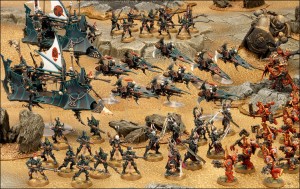Games Workshop put out a new Space Marines codex last week. Recently I started creating army lists and am posting thoughts as I go. Previous thoughts were on Vulkan and Librarians. Up now are the core dudes of any Kingbreakers force: Sternguard, Tacticals, and Transports.
Sternguard
Sternguard got kind of a funny set of changes. The first five went down a point each, but any additional veterans went down three points each. Unfortunately Combi-Weapons went up five. That’s a little problematic for me as I’ve previously relied on a good number of Combi-Meltas. So my 5-man Combat Squad with 3 Combi-Meltas went up 10 points while a 10-man full squad with 6 stayed the same.
Tacticals
Tacticals have a similar story going on. Dudes got cheaper but a bunch of their stuff got more expensive. In general it works out to be kind of a wash. I guess the motivation was to drop equipment price lists from individual units and allow many of them to use the same armoury listings without really changing the overall unit prices from 5e, but that seems kind of a silly, unnecessary reworking.
You also need to pay to upgrade Tactical Sergeants to Veterans and get a second Attack and boosted Leadership. Personally I think the Veteran upgrades are probably worth paying for unless the squad is really not going to wind up in combat at all. Two base attacks plus a bonus third for wielding dual close combat weapons can be pretty decisive against a variety of opponents. In general I’m all for a la carte upgrades—if I don’t want it, why should I implicitly pay for it?—but these might be pushing it a bit. In particular, I think they create an opportunity for minor mistakes and abuses. E.g., I usually upgrade my dudes but one game I don’t to shave points, and I totally forget I didn’t and roll the extra Attack and +1 Leadership all game. Similarly, a large game could easily have ~4–8 Power Armour squads with the option. If I only upgrade my front line, I could easily “forget” and roll on the upgrades when my Devastators wind up getting assaulted, and many opponents aren’t going to catch that in the heat of battle.
Transports
One big difference for some lists is that Razorbacks went up 15 points, to 55. Rhinos and Drop Pods stayed at 35. I’m not sure how reasonable this is. Razorbacks seem to have a pretty solid built in tradeoff versus a Rhino: Carry half as many dudes, but be able to shoot stuff. Paying 5 points for the privilege seemed reasonable, but a 38% premium seems overkill. This seems to be aimed directly at neutering the Razorspam lists floating around in 5e, but I didn’t think they were that prevalent or overpowered, and mostly seemed to be a Blood Angels thing anyway.
Another significant difference is that Drop Pods were reduced back down to a transport capacity of ten, having been able.to carry twelve in 5e.
Kingbreakers
One of the things I had to learn in the previous edition was that cheap Special and Heavy Weapons are a strength of the Marines. Plasmacannons for 5 points were a bargain that had to be taken advantage of; ditto free Missile Launchers. The points changes make it feel like the weapons aren’t a good bargain anymore, at least for Sternguard and Tacticals, but the lesson probably still applies. Similar goes for the Sternguard Combi-Meltas. At first I thought my loadout was going to be too costly, but when you do the math a 10 man squad actually comes up 10 points cheaper.
I do usually bring a Razorback or two, but not enough of them to make that increase super punitive.
The Drop Pod transport capacity decrease is a huge deal for the Kingbreakers though. I can’t get super worked up about it because it just brings them back in line with the other codexes. But 10 Sternguard + Vulkan or a Terminator Librarian coming down in a Drop Pod was a keystone of my battle tactics. The Sternguard have fairly flexible armoury options so it wouldn’t be a huge deal in terms of equipment to cut them down to a squad of 8, whereas Tacticals would miss out on a fancy weapon. The real loss is not being able to Combat Squad that unit anymore. I thought it useful to be able to split up coming out of a Drop Pod, either dividing up existing targets or trying to pop a transport with one and frag the occupants with the other. Not being able to do this with one of my heroes along for the ride isn’t the end of the world, but it’s unfortunate.




